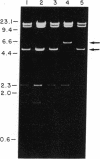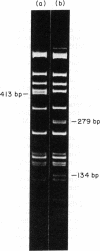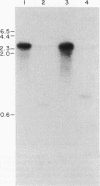Abstract
Gruppuso et al. [Gruppuso, P.A., Gordon, P., Kahn, C. R., Cornblath, M., Zeller, W. P. & Schwartz, R. (1984) N. Engl. J. Med. 311, 629-634] have recently described a family in which hyperproinsulinemia is inherited in an autosomal dominant pattern, suggesting a structural abnormality in the proinsulin molecule as the basis for this disorder. However, unlike two previous kindreds with a similar syndrome, the serum proinsulin-like material in this family did not appear to be an intermediate conversion product but instead behaved like normal human proinsulin by several criteria. To further characterize this disorder we isolated and sequenced the insulin gene of the propositus. Leukocyte DNA was cloned into lambda-WES and recombinants containing the two insulin alleles, lambda MD41 and lambda MD51, were isolated by plaque hybridization. DNA sequencing of lambda MD51 showed that it contained the normal coding sequence for human preproinsulin. Sequence analysis of lambda MD41, however, revealed a single nucleotide substitution in the codon for residue 10 of proinsulin (CAC----GAC) that predicts the exchange of aspartic acid for histidine in the insulin B chain region. This mutation was also found in an insulin allele cloned from a second affected family member (propositus's father). These results, along with the linkage analysis of Elbein et al. [Elbein, S.C., Gruppuso, P., Schwartz, R., Skolnick, M. & Permutt, M.A. (1985) Diabetes 34, 821-824], strongly implicate this mutation as the cause of the hyperproinsulinemia in this family. Inhibition of the conversion of proinsulin to insulin may be related to altered folding and/or self-association properties of the [Asp10]proinsulin.
Full text
PDF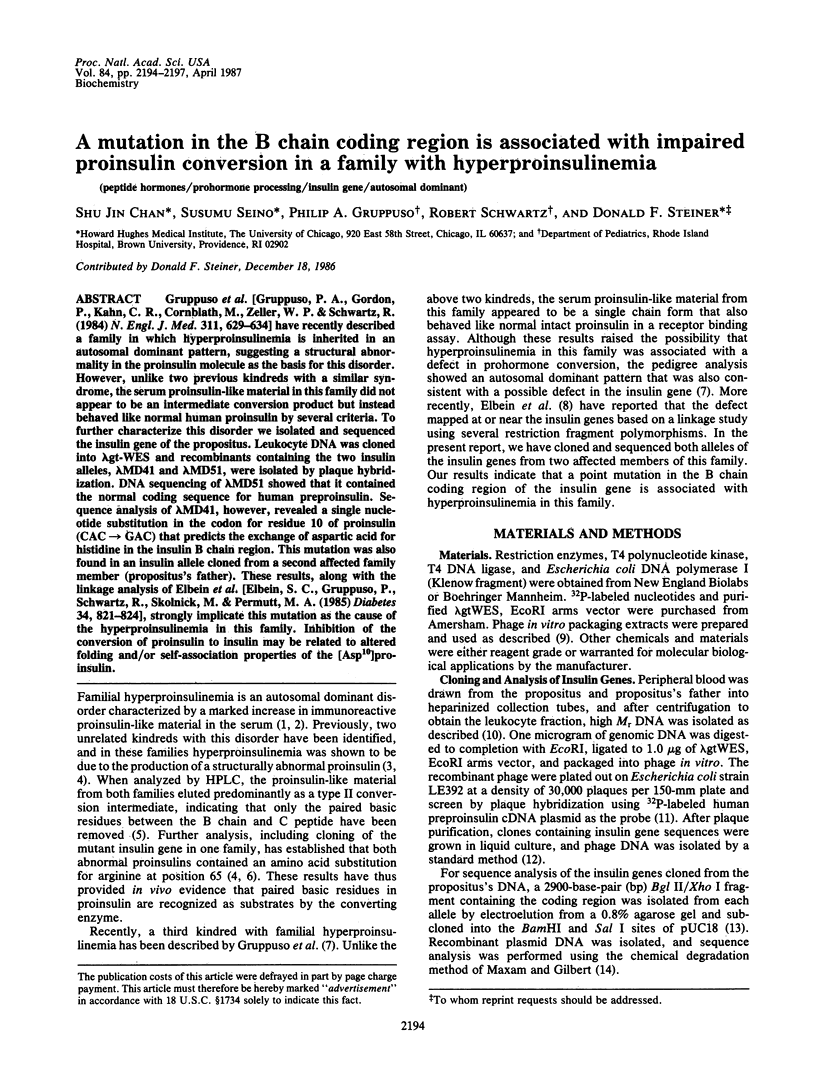
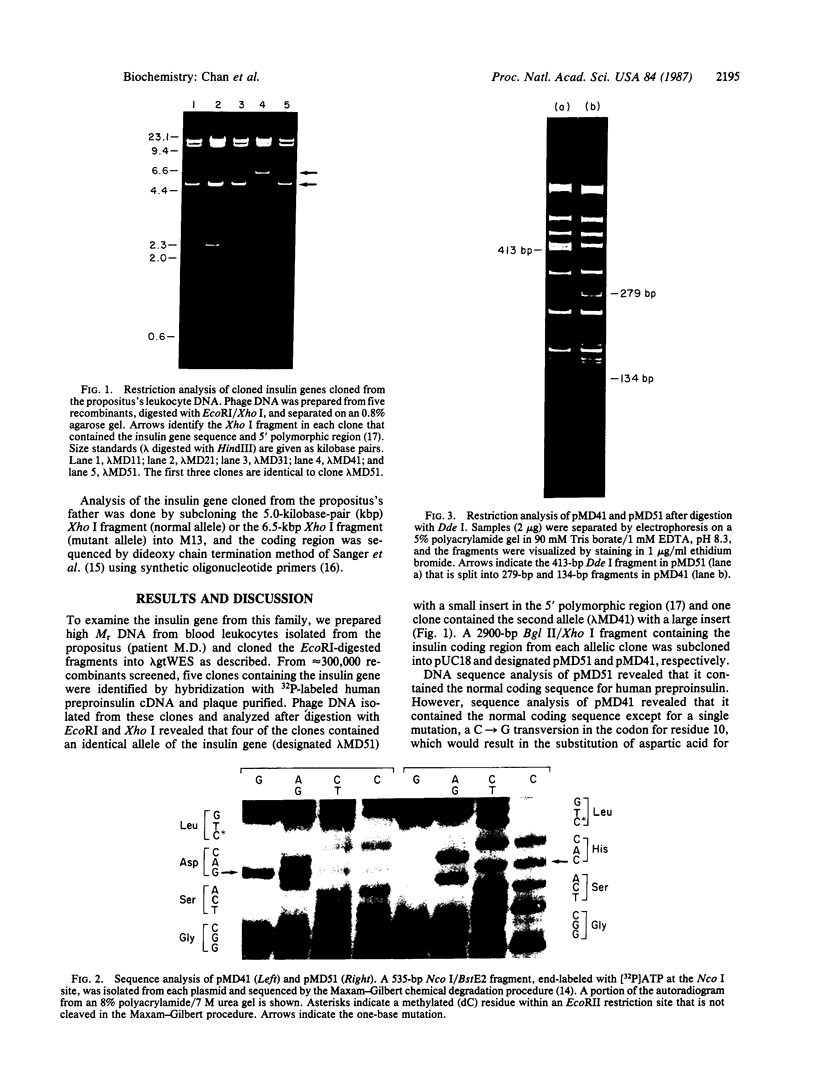
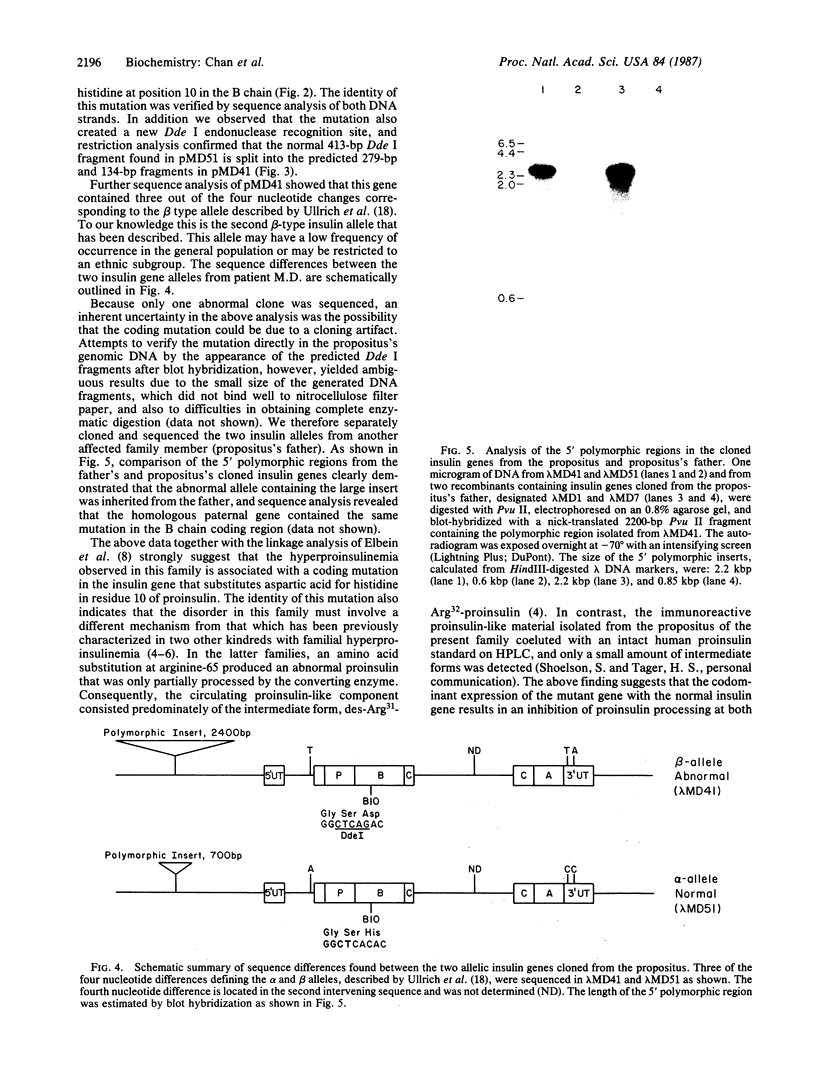
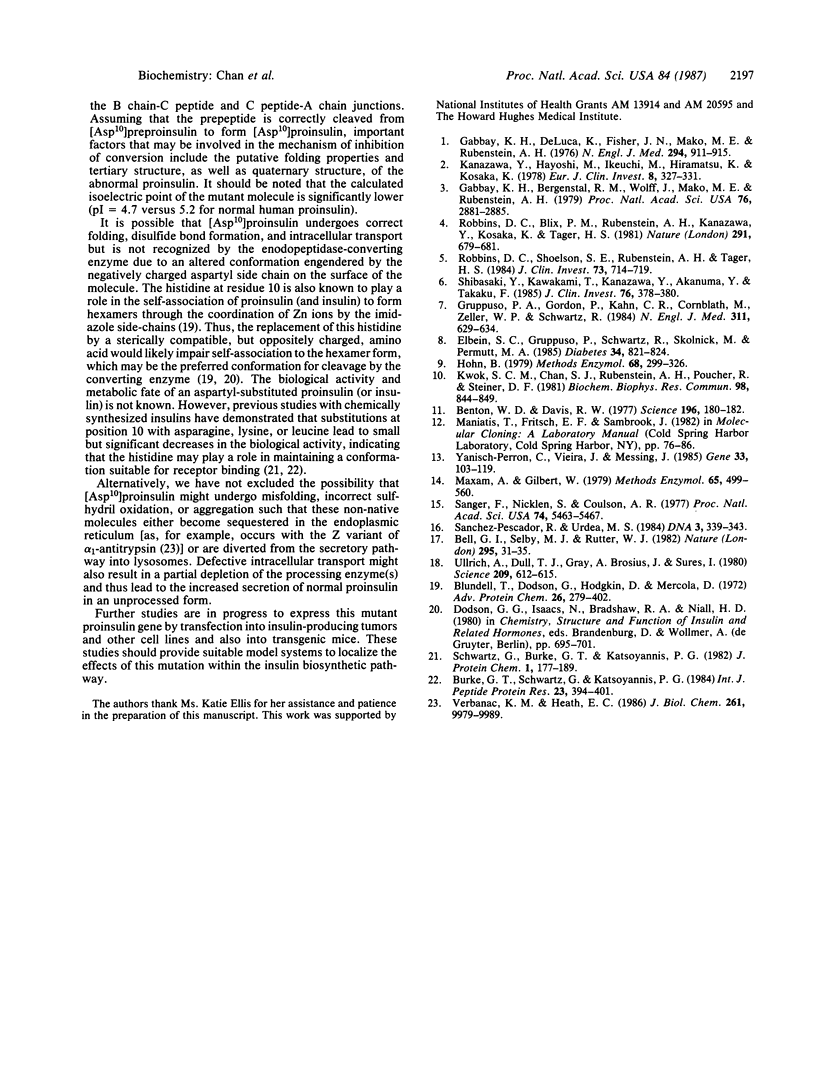
Images in this article
Selected References
These references are in PubMed. This may not be the complete list of references from this article.
- Bell G. I., Selby M. J., Rutter W. J. The highly polymorphic region near the human insulin gene is composed of simple tandemly repeating sequences. Nature. 1982 Jan 7;295(5844):31–35. doi: 10.1038/295031a0. [DOI] [PubMed] [Google Scholar]
- Benton W. D., Davis R. W. Screening lambdagt recombinant clones by hybridization to single plaques in situ. Science. 1977 Apr 8;196(4286):180–182. doi: 10.1126/science.322279. [DOI] [PubMed] [Google Scholar]
- Burke G. T., Schwartz G., Katsoyannis P. G. Nature of the B10 amino acid residue. Requirements for high biological activity of insulin. Int J Pept Protein Res. 1984 Apr;23(4):394–401. doi: 10.1111/j.1399-3011.1984.tb02737.x. [DOI] [PubMed] [Google Scholar]
- Elbein S. C., Gruppuso P., Schwartz R., Skolnick M., Permutt M. A. Hyperproinsulinemia in a family with a proposed defect in conversion is linked to the insulin gene. Diabetes. 1985 Aug;34(8):821–824. doi: 10.2337/diab.34.8.821. [DOI] [PubMed] [Google Scholar]
- Gabbay K. H., Bergenstal R. M., Wolff J., Mako M. E., Rubenstein A. H. Familial hyperproinsulinemia: partial characterization of circulating proinsulin-like material. Proc Natl Acad Sci U S A. 1979 Jun;76(6):2881–2885. doi: 10.1073/pnas.76.6.2881. [DOI] [PMC free article] [PubMed] [Google Scholar]
- Gabbay K. H., DeLuca K., Fisher J. N., Jr, Mako M. E., Rubenstein A. H. Familial hyperproinsulinemia. An autosomal dominant defect. N Engl J Med. 1976 Apr 22;294(17):911–915. doi: 10.1056/NEJM197604222941701. [DOI] [PubMed] [Google Scholar]
- Gruppuso P. A., Gorden P., Kahn C. R., Cornblath M., Zeller W. P., Schwartz R. Familial hyperproinsulinemia due to a proposed defect in conversion of proinsulin to insulin. N Engl J Med. 1984 Sep 6;311(10):629–634. doi: 10.1056/NEJM198409063111003. [DOI] [PubMed] [Google Scholar]
- Hohn B. In vitro packaging of lambda and cosmid DNA. Methods Enzymol. 1979;68:299–309. doi: 10.1016/0076-6879(79)68021-7. [DOI] [PubMed] [Google Scholar]
- Kwok S. C., Chan S. J., Rubenstein A. H., Poucher R., Steiner D. F. Loss of a restriction endonuclease cleavage site in the gene of a structurally abnormal human insulin. Biochem Biophys Res Commun. 1981 Feb 12;98(3):844–849. doi: 10.1016/0006-291x(81)91188-8. [DOI] [PubMed] [Google Scholar]
- Maxam A. M., Gilbert W. Sequencing end-labeled DNA with base-specific chemical cleavages. Methods Enzymol. 1980;65(1):499–560. doi: 10.1016/s0076-6879(80)65059-9. [DOI] [PubMed] [Google Scholar]
- Robbins D. C., Blix P. M., Rubenstein A. H., Kanazawa Y., Kosaka K., Tager H. S. A human proinsulin variant at arginine 65. Nature. 1981 Jun 25;291(5817):679–681. doi: 10.1038/291679a0. [DOI] [PubMed] [Google Scholar]
- Robbins D. C., Shoelson S. E., Rubenstein A. H., Tager H. S. Familial hyperproinsulinemia. Two cohorts secreting indistinguishable type II intermediates of proinsulin conversion. J Clin Invest. 1984 Mar;73(3):714–719. doi: 10.1172/JCI111264. [DOI] [PMC free article] [PubMed] [Google Scholar]
- Sanchez-Pescador R., Urdea M. S. Use of unpurified synthetic deoxynucleotide primers for rapid dideoxynucleotide chain termination sequencing. DNA. 1984 Aug;3(4):339–343. doi: 10.1089/dna.1.1984.3.339. [DOI] [PubMed] [Google Scholar]
- Sanger F., Nicklen S., Coulson A. R. DNA sequencing with chain-terminating inhibitors. Proc Natl Acad Sci U S A. 1977 Dec;74(12):5463–5467. doi: 10.1073/pnas.74.12.5463. [DOI] [PMC free article] [PubMed] [Google Scholar]
- Shibasaki Y., Kawakami T., Kanazawa Y., Akanuma Y., Takaku F. Posttranslational cleavage of proinsulin is blocked by a point mutation in familial hyperproinsulinemia. J Clin Invest. 1985 Jul;76(1):378–380. doi: 10.1172/JCI111973. [DOI] [PMC free article] [PubMed] [Google Scholar]
- Ullrich A., Dull T. J., Gray A., Brosius J., Sures I. Genetic variation in the human insulin gene. Science. 1980 Aug 1;209(4456):612–615. doi: 10.1126/science.6248962. [DOI] [PubMed] [Google Scholar]
- Verbanac K. M., Heath E. C. Biosynthesis, processing, and secretion of M and Z variant human alpha 1-antitrypsin. J Biol Chem. 1986 Jul 25;261(21):9979–9989. [PubMed] [Google Scholar]
- Yanisch-Perron C., Vieira J., Messing J. Improved M13 phage cloning vectors and host strains: nucleotide sequences of the M13mp18 and pUC19 vectors. Gene. 1985;33(1):103–119. doi: 10.1016/0378-1119(85)90120-9. [DOI] [PubMed] [Google Scholar]



